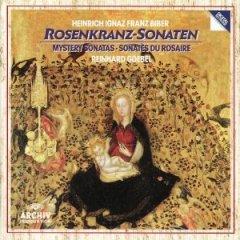Biber - Sonates Du Rosaire (Goebel) [1991]
Biber - Sonates Du Rosaire (Goebel) [1991]

CD1 1. Sonata I: The Annunciation 4:39 2. Sonata II: The Visitation - Sonata - Presto - Allemande - Presto 5:51 3. Sonata III: The Nativity - Sonata - Presto - Adagio - Courante - Double - Adagio Adagio 5:35 4. Sonata IV: The Presentation - with 12 variations 7:41 5. Sonata V: The Finding in the Temple - Prealudium - Presto - Allemande - Gigue – Sarabande 7:35 6. Sonata VI: The Agony in the Garden - Lamento - Adagio - Presto - Adagio I-III 7:03 7. Sonata VII: The Scourging of Jesu - Allemande - Variatio - Sarabande - Variatio 8:37 8. Sonata VIII: The Crowing Of Jesus With Thorns - Adagio - Presto - Gigue – Double I. Presto - Double II 6:00 CD2 1. Sonata IX: Jesus carries His Cross - Sonata - Courante - Double - Finale 5:45 2. Sonata X: The Crucifixion - Praeludium - Aria (with 5 Variations) 8:11 3. Sonata XI: The Resurrection - Sonata - Adagio 6:27 4. Sonata XII: The Ascension - Intrada - Aria Tubicinum - Allemande - Courante - Double I 7:38 5. Sonata XIII: The Descent Of The Holy Ghost - Sonata - Gavotte - Gigue - Sarabande 7:00 6. Sonata XIV in D "The Assumption of Our Lady" - Grave - Adagio - AriaI Aria II - Gigue 8:03 7. Sonata XV: The Crowing of the Blessed Virgin Mary - Sonata - Aria - Canzone – Sarabande 9:43 8. Passacaglia g-moll - without tempo indication - adagio - allegro - adagio 6:42 Reinhard Goebel - violin Phoebe Carrai - Violoncello Konrad Junghanel - Lute Andreas Spering - Harpsichord & Organ.
Dans ces Sonates du Rosaire, Biber invente un style virtuose et fulgurant des plus osés pour son temps. Il fait du violon son véritable porte-parole. Reinhardt Goebel nous offre évidemment une version pleine de fougue et de puissance. A la tête de son ensemble Musica Antiqua de Cologne, il bouscule la partition pour nous en livrer une interprétation tout simplement ébouriffante. On reste sans voix après l'écoute ! --Marc Aigneaux, Editorial Reviews
Biber was among the most talented violin virtuosos and imaginative composers for his instrument during the second half of the seventeenth century. The 15 Mystery or Rosary Sonatas with their additional Passacaglia for unaccompanied violin were written in about 1678 and dedicated to Biber's employer, Max Gandolph, Archbishop of Salzburg. Each sonata is inspired by a section of the Rosary devotion of the Catholic Church which offered a system of meditation on 15 "Mysteries" from the lives of Jesus and His mother. The music is not, strictly speaking programmatic though Biber's skill at conveying specific images is often startlingly vivid. This we find above all, perhaps, in those sonatas related to scenes leading to the Crucifixion. All but the opening Sonata and the concluding Passacaglia require scordatura (retuning of the violin strings from the standard fifths). By so doing Biber extended the technical range of the violin, facilitated fingerings and achieved resonances which would otherwise have been unavailable to him. The 15 sonatas are disposed into three groups of five: Joyful, Sorrowful and Glorious Mysteries whose contrasting affections are evoked in music whose spirit ranges from a characteristically South German baroque exuberance to one of profound and tender contemplation. --- N.A., gramophone.net
download: uploaded anonfiles mega 4shared mixturecloud yandex mediafire ziddu
Zmieniony (Poniedziałek, 26 Sierpień 2013 14:27)








